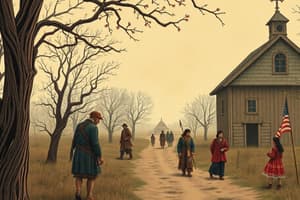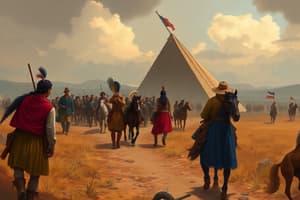Podcast
Questions and Answers
What tribe lived in the southeast U.S. and tried to assimilate into Christianity?
What tribe lived in the southeast U.S. and tried to assimilate into Christianity?
- Seminole
- Apache
- Cherokee Indians (correct)
- Sioux
Who was the seventh President of the United States known for his harsh policy against Native Americans?
Who was the seventh President of the United States known for his harsh policy against Native Americans?
Andrew Jackson
What did the Indian Removal Act of 1830 accomplish?
What did the Indian Removal Act of 1830 accomplish?
- It allowed tribes to maintain their lands.
- It removed all Indians east of the Mississippi. (correct)
- It was a treaty between the U.S. and Native Americans.
- It granted land to Native Americans.
What was the forced journey of the Cherokee Indians called?
What was the forced journey of the Cherokee Indians called?
Who was the leader of the Seminole that resisted removal from Florida?
Who was the leader of the Seminole that resisted removal from Florida?
What act passed in 1862 gave public land to settlers?
What act passed in 1862 gave public land to settlers?
What treaty required the Sioux to live on a reserve along the Missouri River?
What treaty required the Sioux to live on a reserve along the Missouri River?
Who led the attack on Custer at the Battle of Little Bighorn?
Who led the attack on Custer at the Battle of Little Bighorn?
What system allotted land with designated boundaries to Native American tribes?
What system allotted land with designated boundaries to Native American tribes?
What term describes the social process of absorbing one cultural group into harmony with another?
What term describes the social process of absorbing one cultural group into harmony with another?
What did the Plains Indians depend on for food, tool making, and clothing?
What did the Plains Indians depend on for food, tool making, and clothing?
Who was the United States general killed at the Battle of Little Bighorn?
Who was the United States general killed at the Battle of Little Bighorn?
What was the Battle of Little Big Horn also known as?
What was the Battle of Little Big Horn also known as?
What was the religious dance of Native Americans seeking communication with the dead?
What was the religious dance of Native Americans seeking communication with the dead?
What event occurred at Wounded Knee in 1890?
What event occurred at Wounded Knee in 1890?
What act sought to remove Indian land from tribal possession and promote individualism?
What act sought to remove Indian land from tribal possession and promote individualism?
Who authored 'A Century of Dishonor'?
Who authored 'A Century of Dishonor'?
What book detailed the injustices done to Native Americans during U.S. expansion?
What book detailed the injustices done to Native Americans during U.S. expansion?
What book by Dee Brown expressed the Indian perspective on U.S. government injustices?
What book by Dee Brown expressed the Indian perspective on U.S. government injustices?
What Native American organization protested government policies and injustices from 1968?
What Native American organization protested government policies and injustices from 1968?
Flashcards are hidden until you start studying
Study Notes
Native American Tribes and Their Struggles
- Cherokee Indians attempted integration into American society with Christianity and self-governance before forced relocation during the Trail of Tears.
- Osceola was a Seminole leader who resisted the U.S. government's removal policies and died under dubious conditions post-surrender.
U.S. Policies and Key Legislation
- Andrew Jackson, as the seventh President, endorsed the Indian Removal Act, facilitating the displacement of Native Americans.
- The Indian Removal Act of 1830 mandated the relocation of tribes east of the Mississippi River to designated Indian Territory in Oklahoma.
Events of Forced Relocation
- The Trail of Tears marked a tragic journey resulting in thousands of Cherokee fatalities from exposure, disease, and starvation during their forced migration from Georgia.
- Wounded Knee site witnessed a massacre in 1890, where 150-370 Sioux died following the Ghost Dance movement, marking the last major conflict between Native Americans and U.S. government forces.
Military Conflicts and Resistance
- Sitting Bull, a prominent Sioux chief, led the successful resistance against Colonel George A. Custer's forces at the Battle of Little Bighorn.
- Little Big Horn in 1876 became known as "Custer's Last Stand," symbolizing both military failure and the brutal realities of the Indian wars as Custer's ill-advised attack resulted in heavy losses.
Assimilation Efforts and Cultural Impact
- The Dawes Act aimed to dismantle tribal land ownership, redistributing land to individual Native American families to promote assimilation and individualism, yet many struggled to comprehend its implications.
- The Ghost Dance represented a spiritual movement among Native Americans seeking connection with ancestral spirits and hope for the future amid oppression.
Legislative Agreements and Treaties
- The Treaty of Fort Laramie sought to temporarily alleviate tensions by closing the Bozeman Trail, abiding Sioux to designated reservations, although it ultimately failed to prevent conflicts.
Literature and Advocacy
- Helen Hunt Jackson's book "A Century of Dishonor" exposed U.S. government injustices against Native Americans, raising public awareness and sympathy for their plight.
- Dee Brown's "Bury My Heart at Wounded Knee" articulates Native American perspectives on the injustices suffered, reinforcing the narrative of betrayal by the U.S. government.
Modern Organizations
- The American Indian Movement, formed in 1968, advocated for the rights of Native Americans, organizing significant protests, including the armed occupation of Wounded Knee in 1973.
Economic and Industrial Factors
- The Transcontinental Railroad facilitated U.S. industrial growth and westward expansion, significantly impacting Native American lands and livelihoods.
- The Homestead Act of 1862 provided 160 acres of land to settlers willing to cultivate it for five years, further encroaching on Native American territories.
Ecosystem and Survival
- Plains Indians heavily relied on buffalo for sustenance, clothing, and tools, making their survival intricately linked to the fate of these animals amid westward expansion.
Studying That Suits You
Use AI to generate personalized quizzes and flashcards to suit your learning preferences.




